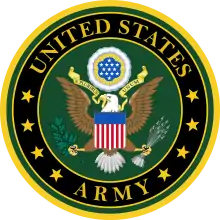Uniforms of the United States Army
The uniforms of the United States Army distinguish soldiers from other service members. U.S. Army uniform designs have historically been influenced by British and French military traditions, as well as contemporary U.S. civilian fashion trends. The two primary uniforms of the modern U.S. Army are the Army Combat Uniform, used in operational environments, and the Army Green Service Uniform worn during everyday professional wear and during formal and ceremonial occasions that do not warrant the wear of the more formal blue service uniform.
History
The design of early army uniforms was influenced by both British and French traditions. One of the first Army-wide regulations, adopted in 1789, prescribed blue coats with colored facings to identify a unit's region of origin: New England units wore white facings, southern units wore blue facings, and units from Mid-Atlantic states wore red facings.[1] Bandsmen wore red uniforms to make them more easily identifiable to commanders on the field of battle. Pantaloons were originally white, following British uniforms, but were changed to gray in 1821 and sky blue in 1832. Infantry wore tricorne hats, with different cover prescribed for cavalry and specialist troops depending on function.
The original Revolutionary War enlisted uniform jacket was dark blue with state-specific facing colors. This was worn with a white waistcoat and breeches and black shoes. All ranks wore a black tricorne hat with a black cockade; later a white cockade was inset to represent the American alliance with Bourbon France. From 1782, Regulars had red facings. Foot regiments (infantry, artillery, and supporting units) wore gold-metal buttons and lace. Horse regiments (cavalry, light dragoons, and horse artillery) wore white-metal buttons and lace. From 1810, the uniform changed to follow European trends. The tight-fitting and short-skirted double-breasted coatee replaced the single-breasted coat, and the waistcoat was discontinued. Militia wore gray coatees (still worn as a ceremonial uniform at West Point today) and regulars wore national blue (dark-blue) coatees (except for musicians, who wore reversed red coatees with blue facings). Enlisted ranks wore the coatee with a black stovepipe shako, white or gray trousers with matching button-up spats, and black short boots. Facings and buttonhole trim were discontinued in 1813. From the early days of the Continental Army the wearing of a sword and a worsted crimson sash served as a badge of rank for all sergeant grades, but by 1820 the worsted sash became a privilege to first sergeants and above only (from 1781, until 1833, the "first sergeant" was simply the senior sergeant in a company or battery and was not a separate grade of rank).[2]
Beginning in the 1850s, U.S. military leadership began to place an increased emphasis on French army tactics and styles, influenced, in part, by the rise of Napoleon III.[3] The most extreme examples showing the adoption of French military fashion was in the use of zouave uniforms by some U.S. Army infantry regiments, and the purchase of 10,000 chasseurs à pied uniforms to outfit the Excelsior Brigade.[4] However, more subtle styling - including frock coats, kepi hats, and collar ornaments - also made their way into U.S. Army uniform design preferences.
From the early 1900s through the end of the World War II, the U.S. Army went through several styles of khaki and olive drab uniforms and, by 1954, settled on the Army Green Uniform for service dress[5] which was eventually pulled from service in 2010. An alternate semi-dress uniform authorized for officers during the summer months, the Army Khaki Cotton Uniform continued in use until 1985. Field dress during this period was either the Army Tropical Uniform, or the M1951 wool field uniform. These were followed in 1981 by the Battle Dress Uniform, which was pulled from use in favor of the Army Combat Uniform in the mid-2000s.
18th century
In 1774, a blue Continental Army coat, with state facing colors, and white waistcoat and breeches or overalls was worn. The origin of "blue" as the primary uniform color is earlier during the Colonial period of the Continental Association or First Continental Congress which met in Philadelphia, PA and adjourned on October 26, 1774. George Washington was the appointed Presiding Officer.
While Washington was in Philadelphia, one hundred neighbors in Fairfax County (VA), under the tutelage of George Mason, had organized themselves into a voluntary militia—probably the first in the colony—electing Washington their commander. Borrowing the colors of the English Whig party, the Fairfax Independent Company wore blue uniforms with buff facings and white stockings.[6]
Washington used Thomas Webb's A Military Treatise on the Appointments of the Army as a guide for outfitting this particular unit. Washington would soon accept the additional field command of another four independent companies: in Prince William, Fauquier, Richmond, and Spotsylvania Counties.[7]
By 1782, red facings only with branch of service white (infantry) or yellow (artillery) metal buttons were worn.
19th century
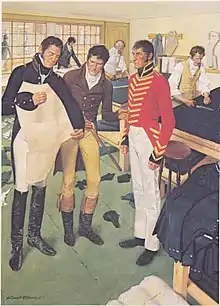


- 1810: French uniform coat with cut-in skirt fastened in front; sleeved roundabout jacket for fatigue and field service.
- 1813: Uniform coat devoid of buttonhole lace and facing colors.
- 1821: Congressional confirmation of army wear of national blue; practical gray wool pantaloons for the winter mud, a tradition of contrasting shades.
- 1829: Undress frock (full round skirt) coat in place of officer's civilian clothes.
- 1832: Branch of service cap insignia, gold or silver officer grade insignia on epaulettes and sky-blue trousers for all but staff and generals.
- 1835: Shoulder straps, used to hold fringed epaulettes, with undress, officer grade.
- 1851: French frock (full skirt) coat only uniform, trimmed in system of branch of service colors.
- 1854: New waist-length uniform jacket for mounted troops
- 1872: Blouse for garrison and field, uniform coat for dress, with epaulettes for generals.
- 1881: Dark blue flannel overshirt often in place of blouse on field service.
- 1885: Sky-blue kersey trousers, aniline dye richer shade than original vegetable dye.
- 1895: Officer's undress sack coat, with black trim; branch of service insignia and national cypher "U.S." on collar, with national eagle on cap.
20th century
- 1902: Olive drab wool and khaki cotton service uniforms introduced; blue retained only for dress, full dress, mess dress, and special evening dress, trimmed with branch of service color. New patterns of blue full dress and dress uniforms adopted for both officers and enlisted men [8] Leather color changed from black to russet. The M1902 visored cap is adopted.[9]
- 1907 and 1912: Minor changes prescribed for 1902 model blue dress and full dress uniforms.[10]
- 1911: Wool felt M1911 Campaign Hat adopted. Hat cords were in Branch colors for enlisted men, a gold metallic thread and black cord braid for Subaltern and Field Officers, and woven of gold metallic thread for General Officers.
- 1917: Wearing of blue dress, full dress and mess dress uniforms suspended for the duration of the war. Warrant Officers were authorized a hat cord of silver metallic thread and black cord braid for wear with the M1911 Campaign Hat. The side-folding cloth Overseas Cap was unofficially adopted by AEF personnel in a variety of styles influenced by similar Allied patterns.
- 1921: The M1911 Campaign Hat was redesigned.
- 1928: Return of pre-war blue dress uniforms with new visor cap, optional at expense of wearer.[11]
- 1938: Officer's blue roll-collar coat adopted, with branch of service-color trim and dress belt (from full dress coat).
- 1939: The side-folding Overseas Cap is universally adopted as the Garrison Cap.[12]
- 1940: No blue uniform required during emergency (end of saber).
- 1941: The M1911 Campaign Hat is declared Limited Standard.
- 1947: President Harry S. Truman note on lack of dress uniform and return of pre-war pattern; evening dress uniform cuff with single gold lace and insignia of grade.
- 1953: Post-war officer and EM pattern with patch pockets; no traditional branch of service color trim on EM uniform and officers' trousers stripes.
- 1954: Official adoption of the Army green Class "A" uniform; worn with Army tan shade 46 long-sleeve cotton shirt (with no insignia) and black "four-in-hand" necktie.
- 1956: Distinctive uniform for bands and honor guards. Leather color changed from russet to black.
- 1957: Women's army blue uniform same cut as 1951 Taupe-121 uniform.
- 1959: Army blue uniforms for year-round wear.
- 1962: Women's army blue same as army green uniform, with new service hat.
- 1963: Mandatory possession of officer's army blue uniform.
- 1972: Officers' mess jacket cuff ornamentation simplified to resemble that of 1947 evening dress (grade insignia replaced branch insignia; single strand of gold lace replaced multiple ones which previously showed grade).
- 1979: Army green Class "A" uniform: shirt changed to Army green shade 415 polyester cotton blend shirt with epaulettes for wear of cloth "slip-op" grade of rank insignia.
- 1993: Green changed to a darker shade and pleats added to shirt pockets.[13]
21st century

In 2010 the blue Army Service Uniform (ASU) was issued to all soldiers, with the entire Army wearing the blue ASU,[14] which is meant for formal occasions, such as the graduation from basic combat training. By 2016 the Sergeant Major of the Army (SMA) was urging the wear of the officer's pinks and greens from the World War II era for all soldiers, moving these green ASUs to everyday office dress. By 2028 all soldiers will be wearing the green ASU as office attire.[15]
- 2008: the new blue army service uniform (ASU) is introduced for optional wear by soldiers.[14]
- 2010: blue ASU issued to all soldiers, beginning in autumn.
- 2015: Army green Class "A" uniform officially retired; blue ASU worn army-wide after October 1.
- 2020: New "Army Greens" service uniform will be issued to soldiers reporting to their first units.[15]
- 2028: All soldiers will be required to have the new "Army Greens" uniform for wear.[15]
Current designs
Combat uniform

The Army Combat Uniform (ACU) is the utility uniform worn in garrison and in combat zones by the U.S. Army. It consists of a jacket and trousers worn with combat boots and a t-shirt. A matching patrol cap replaced the black beret for wear with the ACU in July 2011. In the field, the jacket may be replaced by the flame resistant Army Combat Shirt when worn directly under a tactical vest. It was introduced in 2005, replacing the previous Battle Dress Uniform and Desert Camouflage Uniform.
The uniform originally featured a digital camouflage pattern, known as the Universal Camouflage Pattern (UCP), which was designed for use in woodland, desert, and urban environments.[16] However, beginning in 2010, most soldiers operating in Afghanistan were issued ACUs using the commercial MultiCam pattern, which was found to be better suited to that country's terrain.[17] Subsequently, the Operational Camouflage Pattern (OCP), which is similar to MultiCam, was adopted Army-wide starting in 2015, with UCP fully retired in 2019.
Beginning in 2010, a series of changes to the ACU led to the Army Combat Uniform-Alternate, which led to the first combat uniform intentionally designed to fit a female soldier. The changes included the Improved Outer Tactical Vest in 2013, which accommodates a shorter torso.[18]
The ACU jacket bears name tapes, rank insignia, and shoulder patches and tabs, as well as recognition devices such as the U.S. flag patch and the infrared (IR) tab. Two U.S. flag insignia are authorized for wear with the ACU, full-color and subdued IR. The U.S. flag insignia is worn on the right shoulder pocket flap of the ACU coat. Unit patches are worn on the left shoulder, while combat patches are worn on the right. The name tapes, rank, and skill badges are either secured with hook-and-loop fasteners or can optionally be sewn on.
Service uniform
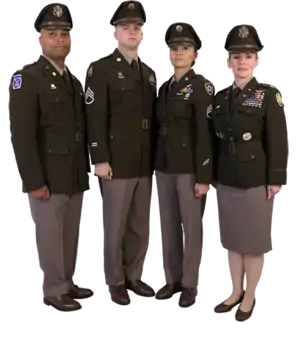
The current garrison service uniform is known as the "Army Service Uniform".[19] In late 2018, a new version based on the "pinks and greens" officers' service uniform worn in World War II and the Korean War was announced.[15][20] The new service uniform includes a dark olive drab coat, light drab trousers, a khaki shirt, an olive drab tie, and brown leather shoes for both men and women, with women having the option to wear a pencil skirt and pumps instead.[21] The uniform became available to soldiers in mid-2020.[22]

From 2010 to 2020, a blue uniform was used as the daily wear service uniform. The Army has a tradition of blue uniforms dating to the Revolutionary War, and the blue uniform returns to its previous position as a formal dress and ceremonial uniform. It had replaced in daily wear the previous green service uniform used by all officers and enlisted personnel introduced in 1956.[23][24]
Mess uniform

Mess dress is the military term for the formal evening dress worn in the mess or at other formal occasions. This is generally worn as the military equivalent of white tie or black tie. The Army has two versions, a blue winter version and a white summer version, each worn with different accessories depending on the formality of the occasion.
The blue mess uniform comprises the Army blue mess jacket, high-waisted trousers, white semiformal dress shirt with a turndown collar, black bow tie, and black cummerbund. The blue trousers are cut along the lines of civilian dress trousers, with a high waist and without pleats, cuffs, or hip pockets. The trouser leg ornamentation consists of an ornamental braid worn on the outside seam of the trouser leg, from the bottom of the waistband to the bottom of the trouser leg. General officers wear pants of the same color as the jacket, with two ½–inch, gold-colored braids, spaced ½ inch apart. Current stated uniform regulation for mess dress is that all other officers and enlisted personnel wear lighter blue trousers with a single 1 ½ inch, gold-colored braid. When worn for white tie events, it is worn with a white formal dress shirt with a wing collar, white waistcoat, and white bow tie instead of the black tie versions.
The white mess uniform is similar, but features a white mess jacket and black high-waisted trousers instead. The trousers are the same for all ranks.
Physical training uniform
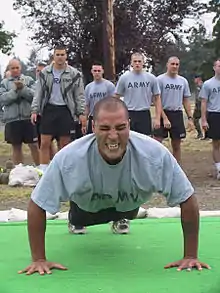
The Army Physical Fitness Uniform (APFU), manufactured by UNICOR and adopted in 2013, is modular, with individual pieces that can be combined or eliminated depending on physical training conditions. All parts of the uniform are styled in black and gold and include track jacket, short-sleeve and long-sleeve T-shirts, track pants, and stretchable running trunks. The uniform was released on October 1, 2014. No standard shoe style is specified to be worn; soldiers are expected simply to purchase commercial running shoes. Shoes with profane or vulgar logos, however, as well as "toe shoes" (such as the Vibram FiveFingers running shoe), are prohibited.[25]
Special ceremonial units
U.S. Army uniform regulations define a class of "special ceremonial units" (SCUs), which include guards units and bands, that are authorized to wear distinctive uniforms – in lieu of the Army Service Uniform – for public duties, including state arrivals, official funerals, change-of-command and retirement ceremonies, and the presidential inaugural parade.
 Uniform of a drummer in the 3rd Infantry Regiment Fife and Drum Corps
Uniform of a drummer in the 3rd Infantry Regiment Fife and Drum Corps Uniform of a drum major in the 3rd Infantry Regiment Fife and Drum Corps
Uniform of a drum major in the 3rd Infantry Regiment Fife and Drum Corps Uniform of a soldier in the Commander-in-Chief's Guard
Uniform of a soldier in the Commander-in-Chief's Guard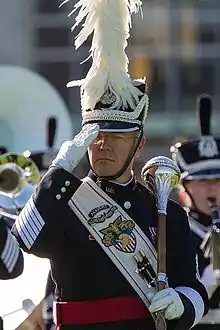 Uniform of a drum major in the West Point Band
Uniform of a drum major in the West Point Band Uniform of a corporal in the First Troop Philadelphia City Cavalry
Uniform of a corporal in the First Troop Philadelphia City Cavalry Uniform of a sergeant in the 1st Cavalry Division Horse Cavalry Detachment
Uniform of a sergeant in the 1st Cavalry Division Horse Cavalry Detachment Uniform of a U.S. Army Herald Trumpeter
Uniform of a U.S. Army Herald Trumpeter Uniform of a U.S. Army Special Bandsman
Uniform of a U.S. Army Special Bandsman Uniform of a U.S. Army Special Band drum major
Uniform of a U.S. Army Special Band drum major
Bands
The U.S. Army has 34 active-duty bands and more than 50 reserve bands. Most of these units wear the Army Service Uniform for public duties, however, certain units – primarily located in the National Capital Region – have unit-specific uniforms that are used for special occasions. Unlike the Army Service Uniform, these specialized uniforms are, for budgetary reasons, generally issued to units – instead of individuals – and returned to the unit following the soldier's departure.
The U.S. Army Band "Pershing's Own", the U.S. Army Field Band, and the U.S. Army Herald Trumpets wear a parade uniform designed by the U.S. Army Institute of Heraldry and introduced in 1969 for the inauguration of Richard Nixon. The uniform blouse has a choker-style collar, instead of the open collar used on the Army Service Uniform, and eight buttons, representing the eight notes of the musical scale. Decorative gold braid adorns the cuffs and standard army cover is replaced by a crimson peaked hat, while drum majors wear a bearskin helmet. A summer white blouse is also available.[26] In the 1950s "Pershing's Own" briefly wore a yellow and black uniform known as "the Lion Tamer" due to its resemblance to a circus costume. Before World War II, the band's uniform was a grey variation of the standard dress blue uniform.
The 3rd Infantry Regiment Fife and Drum Corps wear red, open-front regimental coats, white coveralls, and black tri-corner hats.
The U.S. Military Academy Band – a full-time band assigned to the U.S. Military Academy at West Point - wears distinctive, high-collared navy jackets with white accessories and dark shakos. From 1875 to 1890 the band wore pickelhaube instead of shakos.
Guards
The Commander-in-Chief's Guard, part of the 3rd Infantry Regiment, uses a special dress uniform that is evocative of the uniform worn by Gen. George Washington's life guard. It consists of open-front, blue regimental coats, white coveralls, and black tricorner hats.
The First Troop Philadelphia City Cavalry (a Pennsylvania National Guard unit) has a special full-dress uniform known for its distinctive helmet with extravagant bearskin roach.[27]
The 1st Cavalry Division's Horse Detachment was given status as a Special Ceremonial Unit in 1972. Their parade uniform consists of a navy "fireman's shirt", worn with Columbia blue trousers with yellow piping. Accoutrements include a divisional kerchief worn around the neck and yellow suspenders. Cover is the Cavalry Stetson.
Other non-band SCU units with distinctive uniforms include 54th Massachusetts Volunteer Infantry.
Cadet uniforms
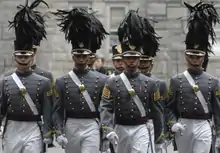
West Point
Cadets enrolled at the United States Military Academy at West Point wear standard Army uniforms, including the Army Combat Uniform and the Army Physical Fitness Uniform, but also use several unique uniforms for drills and daily wear in lieu of the Army Service Uniform. Since 1816, West Point cadet uniforms have been styled in cadet grey which continues to be the primary color used in academy dress.
Spring parade dress consists of cadet grey swallow-tail coats with 21-gold buttons, a standing collar, white trousers, and black shakos (known as a "tarbucket hat" in U.S. Army nomenclature). Winter parade dress is similar to spring parade dress, though trousers are colored cadet gray instead of white. This same uniform is worn without the black shakos hat and with the gray or white peaked service cap depending on the season when not parading but still required for formal events. For evening formal events, no headgear is worn. Summer dress ("India Whites") consist of a white overblouse with a standing collar, white trousers and white peaked service caps. Service dress (“white over gray”) consists of grey trousers, short sleeve white shirts with shoulder boards, and white peaked caps. "Dress Gray" uniforms consist of gray blouses with a standing collar and trimmed with a one-inch black mohair braid band, gray trousers and gray peaked caps. In cold weather, a gray Long Overcoat is worn over the uniform. The daily service uniform ("As for Class") consists of gray trousers, charcoal gray shirts in long sleeve and short sleeve variants and garrison caps.[28]
Senior military colleges
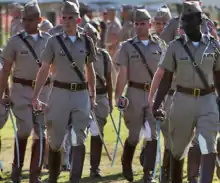
Cadets at senior military colleges are authorized, under Army Regulation 670-1, to wear uniforms developed by their institutions. Regular U.S. Army personnel assigned to those units as instructors may also wear institutionally developed uniforms in lieu of standard army dress. Most corps of cadets at senior military colleges wear uniforms loosely patterned on that of the U.S. Military Academy at West Point. One exception is Texas A&M University which has several styles of unique cadet dress uniforms, the most formal variation being the "Midnight" uniform, consisting of olive drab shirt, "pink" trousers, khaki tie, black low quarter shoes (or brown riding boots for senior cadets), Sam Browne belt, and either peaked hat, Stetson, or side cap, depending on circumstance. The corps' special ceremonial unit, the Ross Volunteers, wear an all-white parade uniform with peaked hat, and the Fish Drill Team, the corps' all-freshman rifle drill squad, wears the "Midnight" uniform with black "paratrooper" boots, white belts, and black polished combat helmet with chromed brass. In general, the Texas A&M Corps' uniforms are virtually identical to those worn by Army personnel during World War II.[29]
ROTC and Junior ROTC units
Reserve Officer Training Corps (ROTC) and Junior ROTC cadets wear the Army service uniform, the Army Combat Uniform and the Physical Training Uniform with some differences in rank, insignia and headgear for the JROTC cadet ASU. The Green Service uniform in its class A and B forms has since been phased out entirely by the class A and B ASU, which cadets now wear for all formal occasions and inspections. Junior ROTC cadets wear gray shirts instead of white shirts and grey berets instead of black berets with their Army service uniform.
Special covers

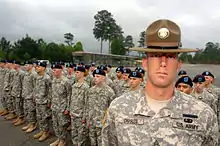

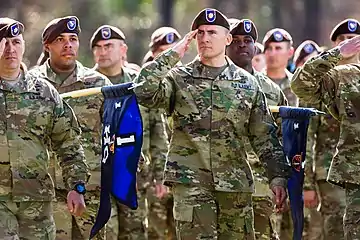
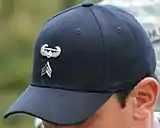
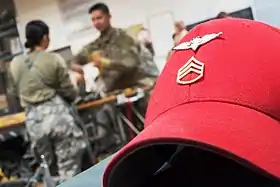
Soldiers assigned to the cavalry units may, during certain divisional functions, replace standard army soft cover (the black beret, the blue peaked hat, or the camouflage patrol cap) with the “Cav Stetson,” a black Stetson with gold braid and cavalry branch insignia.[30]
U.S. Army Drill Sergeants are authorized to wear a campaign hat while in the Army Combat Uniform. First adopted in 1911, the campaign hat was abandoned for drill instructor use during World War II, but readopted in 1964. Army campaign hats are olive green with the Great Seal of the United States centered on the front of the hat on a gold disc.
Several berets in alternate colors to the Army standard black beret are also used. Personnel assigned to units trained and equipped for parachute infiltration, known as airborne forces—such as the 82nd Airborne Division—are authorized to wear the maroon beret while soldiers assigned to the 75th Ranger Regiment wear tan berets. Soldiers who graduate from the Special Forces Qualification Course are authorized to wear the green beret. The Army's newest units, the Security Force Assistance Brigades (SFABs), are authorized to wear a dark-brown beret.
The U.S. Army has also authorized the wear of some distinctive black or red baseball-style caps that are worn by special skill instructors (a.k.a."Black Hats") or Parachute Riggers, respectively.
Highland dress
The U.S. Army tartan, designed by Strathmore Woollen Company, is black, khaki, blue, gold, and two shades of green. The United States Army Psychological Operations Regiment has a separate tartan of green, black, red, gray and white.[31] However, there are currently no U.S. Army units that use Highland dress and the wear of the kilt with U.S. Army uniforms is not permitted by Army regulations. Among armies in the five UKUSA Agreement nations, only the United States and New Zealand do not actively field Scottish units, though both nations have done so in the past.
Nonetheless, in keeping with U.S. Army uniform regulations that permit cadet commands at the U.S. Military Academy and the senior military colleges to introduce institution-specific uniforms, members of the bagpipe bands at West Point (the United States Military Academy), The Citadel (The Military College of South Carolina), Norwich University (The Military College of Vermont), and the Virginia Military Institute wear a Highland uniform while performing as part of their respective ensembles. These uniforms are patterned on collegiate tartans instead of the U.S. Army tartan. The Oregon Civil Defense Force (OSDF) also fields a pipe band that wears a modified Highland uniform, including kilt and sporran, authorized by the Oregon Military Department.
See also
- List of camouflage patterns
- Uniforms of the United States Armed Forces
- U.S. Army M-1943 Uniform
- United States Army uniforms in World War II
References
- David Cole. Survey of U.S. Army Uniforms, Weapons, and Accoutrements (PDF) (Report). U.S. Army. p. 1.
- Perrenot, Preston B. (2011). United States Army Grade Insignia Since 1776 (Revised ed.). CreateSpace Independent Publishing Platform. ISBN 978-1448656875.
- Emerson, William (1996). Encyclopedia of United States Army Insignia and Uniforms. Norman, Oklahoma: University of Oklahoma Press. ISBN 0806126221.
- American Civil War: The Definitive Encyclopedia and Document Collection. ABC-CLIO. 2013.
- "History of U.S. Army Uniforms". military.com. Retrieved 1 January 2014.
- Chernow, Ron (5 October 2010). Washington: A Life. Penguin. ISBN 978-1-59420-266-7. Retrieved 30 October 2012.
- Chernow, p.174
- Randy Steffen. The Horse Soldier, Vol. 3, page 95. ISBN 0-8061-2394-X.
- Jacques Noel Jacobsen, Sections 29 and 30, "Regulations and Notes for the Uniform of the Army of the United States 1902
- Jacques Noel Jacobsen, Parts I & II, "Regulations and Notes for the Uniform of the Army of the United States 1912
- Randy Steffen. The Horse Soldier, Vol. 4, page 66. UE443.S83.
- Mitch Meador, Fort Sill Tribune (July 12, 2019) U.S. Army Field Artillery Museum lets uniforms tell modern Army history Uniforms from Korean War, Khakis, Model 1951 (not worn in Korea until last part of war), herringbone twill, Vietnam War prisoner of war uniform, six uniforms from the Vietnam War, uniforms of two aerial rocket artillery pilots, North Vietnamese Army uniform and a uniform worn by the Viet Cong, MOPP suit, battle dress uniform from 1997, uniform from Operation Desert Storm, 2003 desert combat uniform, and most recent uniform on display made of Nomex
- http://soldiersystems.net/2018/10/10/ausa-18-us-army-pinks-and-greens-update/comment-page-1/#comment-1095202
- AR 670-1, Wear and Appearance of the Army Uniform Insignia
- "U.S. Army to roll out new Army Greens uniform". www.army.mil. U.S. Army. November 11, 2018. Retrieved November 12, 2018.
- FROM
- Lopez, C. (February 20, 2010). "Soldiers to get new cammo pattern for wear in Afghanistan". US Army. US Army. Retrieved February 22, 2010.
- Devon Suits, Army News Service (6 November 2020) On display: Soldier forever enshrined at National Army Museum
- Army Service Uniform
- Garland, Chad (November 11, 2018). "What's old is new: Army rolls out 'pinks and greens' service uniform". Stars and Stripes. Retrieved November 12, 2018.
- Myers, Meghann (November 11, 2018). "It's official: Army approves 'pinks and greens' uniform on Veterans Day". Army Times. Sightline Media Group. Retrieved November 12, 2018.
- Cox, Matthew (June 12, 2020). "New Army Green Uniform Will Soon Be Available for Soldiers to Buy". military.com. Retrieved August 5, 2020.
- https://archive.today/20160505202609/http://www.armytimes.com/story/military/careers/army/2015/10/01/rip-green-service-uniform-1954-2015/73142376/
- The Army Green Uniform - March 1968 Archived 2008-02-13 at the Wayback Machine
- Bacon, Lance M. (August 29, 2011). "'Toe shoes' get the boot, Army-wide". Army Times. Retrieved 2012-07-16.
- "The U.S. Army Band Uniform". U.S. Army Band. Retrieved 31 December 2013.
- Seymour, Joseph (2008). First Troop Philadelphia City Cavalry. Arcadia Publishing. ISBN 0738557676.
- "West Point Cadet Uniforms". usma.edu. U.S. Army. Retrieved 31 December 2013.
- "The Corps Uniform". tamu.edu. Texas A&M University. Retrieved 31 December 2013.
- Philip Battaglia (15 August 2010). Memorandum of Instruction (MOI) Concerning the Wear and Appearance of the CAV Cover and Spurs (Report). Department of the Army.
- "Tartan Details - The Scottish Register of Tartans". www.tartanregister.gov.uk. Retrieved 2020-02-17.
Further reading
- Cole, David (2007). Survey of United States Army Uniforms, Weapons and Accoutrements (PDF). United States Army Center of Military History. Archived from the original (PDF) on 29 December 2009.
- Battle dress through the centuries
External links
| Wikimedia Commons has media related to Uniforms of the United States Army. |

